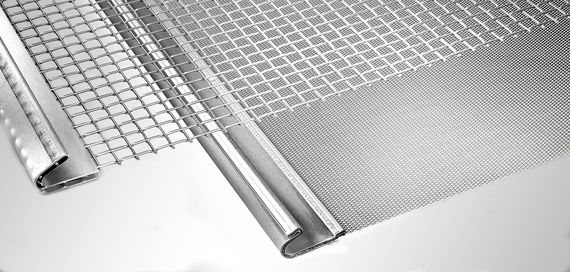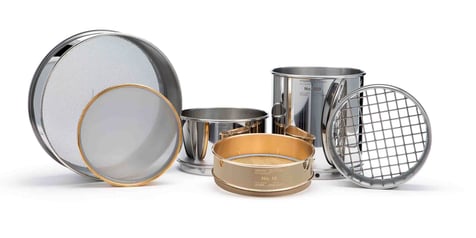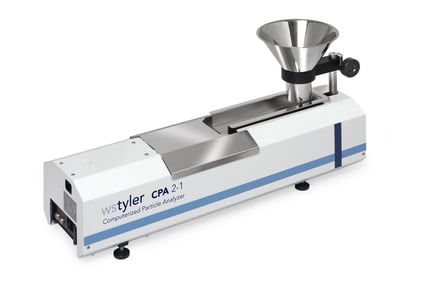Material Testing: Aligning Your Particle Size Analysis Equipment
Test Sieves | Ro-Tap Sieve Shakers | Computer Particle Analyzer | Particle Analysis | Screen Sections | Vibrating Screens | Alpine Air Jet Sieve
Salt, asphalt, and instant coffee. All products that we encounter every day and expect to deliver certain qualities each time we turn to them.
While often unnoticed by the average consumer, something else these products have in common is that they are made up of particles that are uniform in shape and size. This uniformity is what ensures your products provide best-in-class performance.
Now, odds are you have heard of particle size analysis tools such as vibrating screen machines and sieve shakers. But did you know that the most reliable quality control programs use all these pieces of equipment in conjunction to produce products that are just as reliable?
W.S. Tyler has been a leading entity in the particle size analysis industry for over 150 years and strives to use the knowledge within our four walls to help you develop a particle analysis system that is catered to your needs.
For that reason, we wrote the following article to help you understand how the various particle analysis equipment on the market work together to produce the best possible products. You will learn the following:
- Why you should be using equipment to analyze your material
- The equipment you should be considering
- How the equipment work together to analyze material
The Importance of Analyzing Your Material
Most manufacturers of products like baking soda, gravel, sugar, etc., are producing tons of product an hour. When producing these tons per hour, they must be mindful that the size of the particles in each batch falls within a certain threshold.
For this reason, manufacturers turn to various particle size analysis equipment and industry standards to establish whether or not their material falls within an acceptable particle size range.
This ensures the different material grades throughout your production will perform as intended. In other words, if you know your asphalt material adheres to industry standards, you know it will perform under a specific temperature range and under a specific range of pressure from traffic.
Additionally, analyzing your material can provide insight into potential faults in your process. For example, if you notice that a specific sieve is retaining too much material and go back to your production line, you may identify faults such as holes in your vibration screen sections or broken teeth within the crusher.
Failure to properly analyze your material can ultimately result in tons of bad product that can’t be sold, causing unnecessary expenses associated with additional labor and equipment wear.
What Particle Size Analysis Equipment Is Used To Analyze Material?
When implementing a reliable quality control program, manufacturers must implement various particle size analysis instruments to properly screen the particles that make up the final commercial product. This includes vibrating screens, sieve shakers, test sieves, and dynamic image analysis systems.
Fine Wire Cloth Screen Section

A fine wire cloth screen section is a section of woven wire mesh retrofitted with hooks that allow the sections to be inserted and tensioned in large vibrating screen machines. Depending on the specific needs of your operation, a fine wire cloth screen section can be fabricated with a single layer of mesh or two.
A two-layer configuration will consist of a fine screening layer and a more coarse support layer.
Installed into multiple screening decks from course to fine, fine wire cloth screen sections are designed to screen high volumes of material ranging from 4 mesh to 325 mesh.
Get more information about wire mesh vibrating screens in the article below:
Sieve Shaker

A sieve shaker is a device that houses and agitates a test sieve stack, helping the particles of a representative sample find the openings of the sieve. As the particles make their way down the sieve stack, they are stopped when the openings of the test sieve are smaller than their diameter.
This, in turn, results in a representative sample that is separated by size.
With that, there are four main sieve shaker variants to choose from. They are:
Test Sieve

Test sieves are screening instruments that employ woven wire mesh furnished with pore openings that are rigid, consistent, and precise. Having been used for centuries, test sieves are proven to effectively screen sample material and generate accurate and repeatable particle size distribution curves.
For this reason, they are reflected in dozens of industry standards.
Refer to the following article to gain a better understanding of test sieves and how they work:
Dynamic Image Analysis System

A dynamic image analysis system is a device designed to distinguish the profile of the individual particles of your sample material. Using a high-resolution line scan camera with a frequency of 28,000 lines per second, these state-of-the-art devices can analyze up to 10,000 dry, non-agglomerated particles per second.
As the particles are fed past the camera, their silhouettes created using a LED light are captured. This information is fed to dedicated software, which generates the size, shape, sphericity, and circulatory of each particle.
For a more in-depth overview of W.S. Tyler’s Dynamic image analysis system, the Computerized Particle Analyzer, read the article below:
How Do the Various Pieces of Particle Size Analysis Equipment Work as a Unified System?
To start, manufacturers will often have quarries of material and blast material out of the quarry, gathering large pieces of aggregate. These pieces are then placed into an industrial-sized crusher, which works to break down the aggregate pieces.
Now much smaller, these aggregate pieces are placed in a vibrating screen machine for an initial screening. If they are of the right quality, the pieces will undergo additional crushing and screening processes until the particles are of the desired grade.
Once the desired grade of material is achieved, offshoots within the vibrating screens will distribute material into collection areas, such as silos.
At this point, a lab manager responsible for conducting quality checks will take a representative sample from each grade of material. Knowing what distribution curve each grade should have, the lab manager will assemble test sieve stacks specific to each grade.
NOTE: A test sieve stack can be a physical stack of test sieves or digitally created in the software proprietary to your dynamic image analysis system.
Once the test sieve stack is set up, each grade of material will be run on either a sieve shaker or dynamic image analysis.
Be Reassured That Your Particle Size Analysis Results Are Accurate and Repeatable
It is well known that vibrating screens, sieve shakers, test sieves, and dynamic image analysis are the foundation of a trustworthy particle size analysis setup. In order to obtain the results needed to optimize your operation, you must implement a setup that allows these devices to work in conjunction seamlessly.
Now, as you integrate new equipment and tweak your current process, it is important that you trust that your results are reliable. Fortunately, you can lean on third-party companies to test your material and verify that the results you yielded are, in fact, accurate.
Having been a leader of innovation in the particle size analysis industry for over 150 years, W.S. Tyler is here to support your endeavors and help you gain confidence in your results.
Read the article below to gain insight into what to expect when sending your material in to be tested:
About Ronnie Brown
Ronnie is the Content Writer for W.S. Tyler and has four years of experience as a professional writer. He strives to expand his knowledge on all things particle analysis and woven wire mesh to leverage his exceptional writing and graphic design skills, creating a one-of-a-kind experience for customers.




